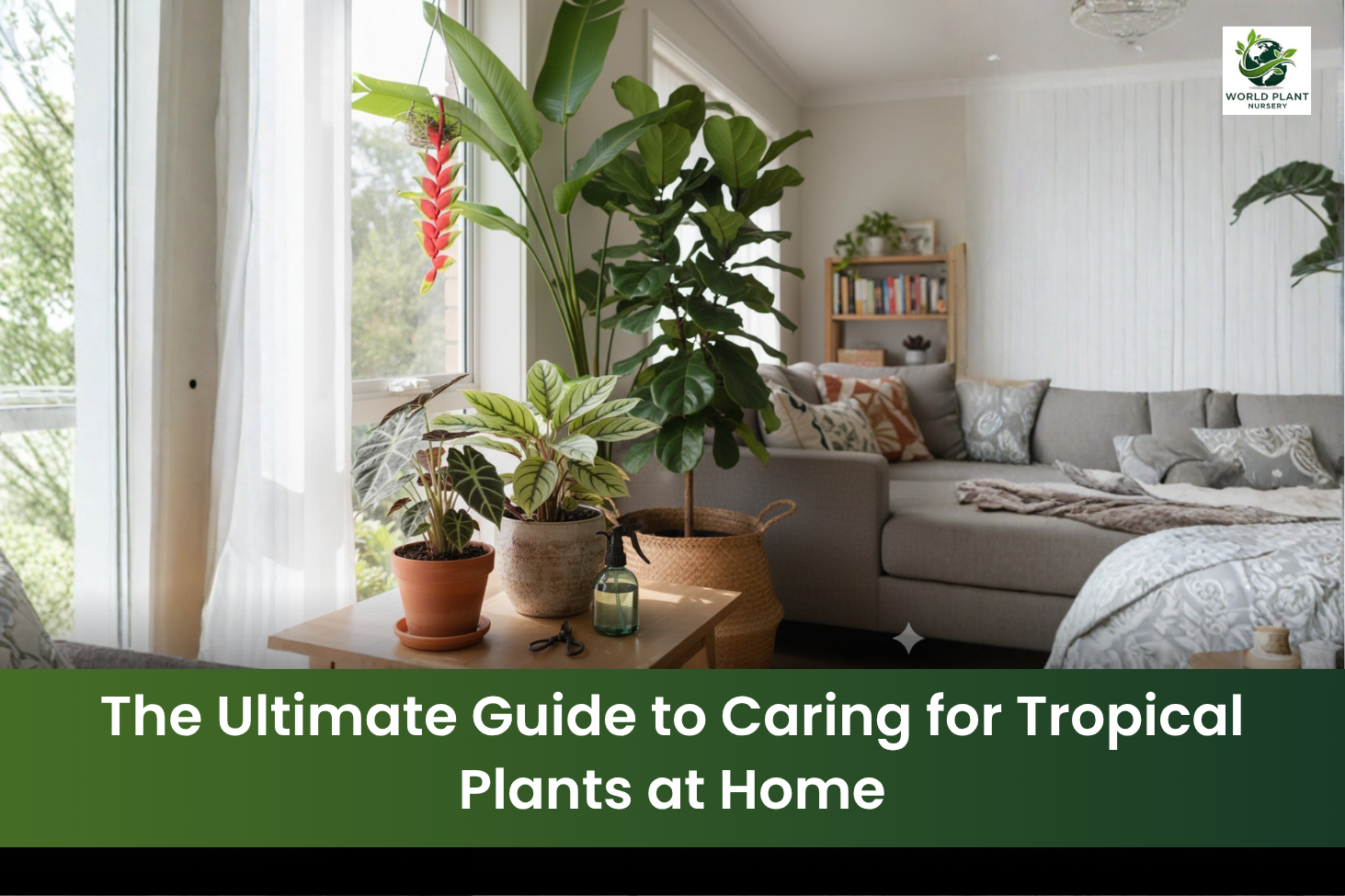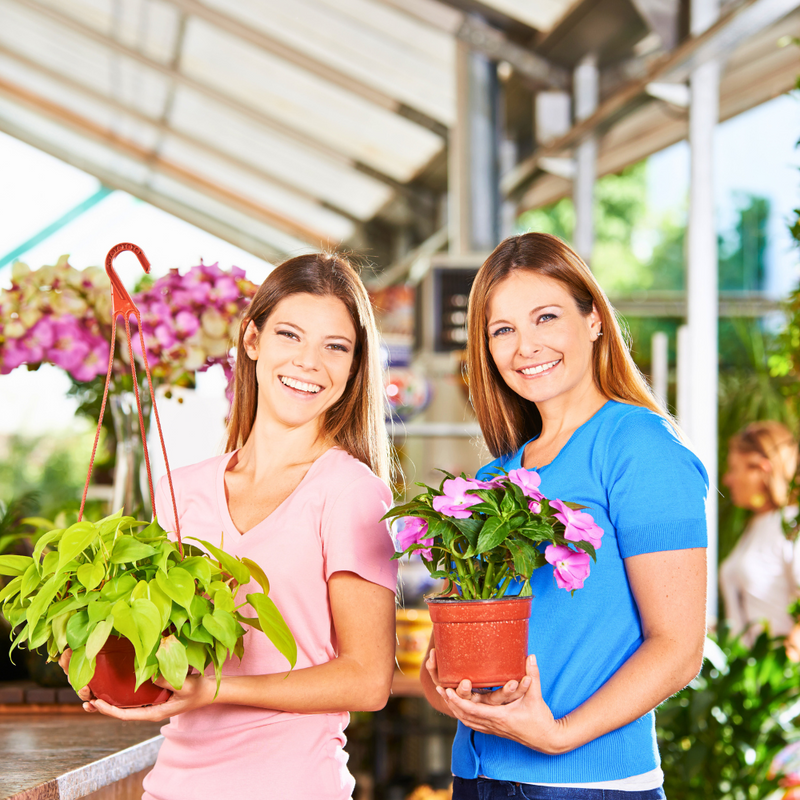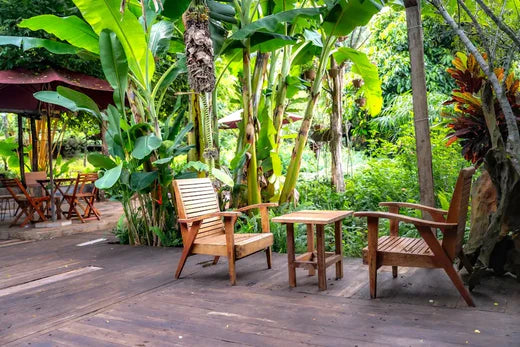Growing tropical plants indoors transforms your space into a lush sanctuary, but success hinges on three fundamentals: bright indirect light, consistent humidity, and proper watering. Most beginners underestimate humidity needs and overwater, which kills plants faster than anything else.
Once you dial in these basics and understand your specific plant's quirks, you'll watch your collection thrive year-round. Whether you're ordering from World Plant Nursery or sourcing locally, knowing how to care for your delivered tropical plants makes the difference between thriving greenery and disappointing decline.
What Makes Tropical Plants Different From Regular Houseplants?
Tropical plants evolved in rainforest environments where conditions are dramatically different from most homes. They didn't develop in dry living rooms or under harsh artificial light, they grew under dense canopy shade with consistent warmth and moisture in the air.
This matters because it explains why a tropical plant sitting on your bookshelf near a heating vent slowly declines. That plant isn't dramatic or needy; it's stressed. It's like moving a fish from saltwater to freshwater and expecting it to be fine.
The key differences are:
Light requirements are subtly different. While we say tropical plants prefer "indirect light", what they really need is bright, filtered light similar to a dappled tropical rainforest canopy. They've adapted to thrive without direct sun beating on their leaves, which would damage them. A north-facing window or spot three feet from a south-facing window often works better than you'd expect.
Humidity levels matter more than people realise. Indoor humidity typically hovers around 30-40%, while tropical rainforest plants evolved in 70-90% humidity environments. This single factor accounts for more tropical plant deaths than any other issue, leaves brown at the edges, growth slows, and spider mites show up as your plant weakens.
Watering patterns differ because tropical soils stay consistently moist (not wet) in nature. Rain falls frequently, but the jungle soil drains quickly due to organic matter and aeration. You need that same balance, moisture without waterlogging.
Temperature consistency matters too. Tropical plants don't experience the dramatic seasonal swings that temperate plants handle easily. A sudden drop to 50°F can shock the system, while temperature stability helps them thrive.
How Should You Set Up Your Indoor Tropical Growing Environment?
Before bringing home your first tropical plant or ordering tropical plants for sale online, create the right conditions. This investment prevents common problems and accelerates growth dramatically.
Lighting setup is your starting point. Identify your brightest indirect location, ideally an east- or west-facing window where morning or afternoon sun bounces off walls or trees before reaching plants. If you have south-facing windows, place tropical plants at least three to four feet away or use sheer curtains to filter harsh midday rays. North-facing windows work for low-light-tolerant species like Pothos or ZZ plants but won't be enough for high-light lovers like Anthuriums or Bird of Paradise.
Many people discover they need supplemental lighting. A simple LED grow light on a 10-12 hour timer costs $30-60 and transforms a dark corner into a productive zone. Position it 12-24 inches above plants depending on the light's wattage. This isn't cheating, it's recreating the dappled canopy your plants evolved under.
Humidity solutions range from simple to sophisticated. The easiest method is grouping plants together. Plants transpire water through their leaves, creating a microclimate of higher humidity when plants cluster. Surround this grouping with a humidity tray, a shallow tray filled with pebbles and water, with plants sitting on top of the pebbles (not in water). As water evaporates, it raises humidity around your plants.
A $40-60 humidifier becomes worthwhile if you have more than five tropical plants. Run it for 4-6 hours daily, which costs pennies in electricity. Alternatively, misting helps temporarily but isn't reliable for consistent humidity, think of it as a supplement, not a solution.
Soil and drainage setup prevents 80% of tropical plant problems. Don't use regular potting soil for tropical plants. Create a chunky, well-draining mix:
- 40% quality potting soil
- 30% orchid bark
- 20% perlite
- 10% worm castings
This allows roots to breathe, drains excess water within minutes, and replicates the organic forest floor texture tropical plants prefer. Invest in pots with drainage holes, this isn't optional. Without drainage holes, you're playing roulette with root rot.
Temperature zones in your home matter more than you'd think. Tropical plants prefer 65-75°F during the day, with nighttime temperatures staying above 60°F. Avoid placing them near heating vents, AC units, or cold windows during winter. The spot you've chosen as perfect for aesthetics might be terrible for plant health if it's subject to temperature swings.
Why Is Humidity So Critical for Tropical Plants?
This is where I see people struggle most. Understanding humidity transforms your success rate from 50% to 90%.
Humidity controls transpiration, the process where plants release water through leaves. In rainforests, this released water is recycled and remains in the canopy. In your living room, water evaporates into the dry air, and leaves never pull water back up through roots. The result? Leaf browning, slower growth, and increased pest vulnerability.
Low humidity triggers additional stress responses. Your plant doesn't "know" it's in your home, it just knows humidity has dropped dangerously. The plant closes stomata (leaf pores), reducing gas exchange and photosynthesis. Growth slows dramatically, leaves yellow, and the plant essentially enters survival mode.
Spider mites exploit humidity-stressed plants aggressively. These pests thrive in dry air and reproduce rapidly on weakened plants. A tropical plant in 30% humidity with spider mites will decline quickly. The same plant in 65% humidity might shrug off a minor spider mite issue. Humidity is like your plant's immune system.
Tropical pitcher plants demonstrate this principle perfectly. These remarkable carnivorous tropical plants need 60-75% humidity consistently. Without it, the pitcher structures fail to form, traps don't develop, and the plant becomes a sad green blob. But in proper humidity? These plants produce beautiful, functional traps and grow vigorously.
The practical standard: Aim for 50-65% humidity as your baseline. If you can reach 65-75%, tropical plants truly thrive. Below 40%, you're fighting an uphill battle.
When Should You Water Tropical Plants?
Watering is where most people either kill plants by underwatering or drown them out of kindness.
The critical insight: Tropical plants need consistently moist soil, not wet soil. If you're used to other houseplants that prefer drying between waterings, this is your adjustment point.
Check before watering using the finger test. Insert your finger 1-2 inches into soil. If it feels moist, wait. If it feels dry at this depth, it's time to water. For most tropical plants during the growing season (spring/summer), this means watering every 4-7 days depending on humidity, pot size, and light conditions.
Water thoroughly when you do water. Pour water until it drains from the bottom holes, never use spray bottles as your primary watering method. Spray bottles don't deliver adequate water; they're useful for foliar misting to increase humidity, but that's different. Thorough watering ensures even soil saturation and prevents salt buildup.
Seasonal adjustments matter. During fall and winter, growth slows, and tropical plants need less water. The same plant that needed watering twice weekly in June might need watering just once weekly in December. Watch the soil more than the calendar. In winter, I typically water every 7-10 days depending on heating and humidity conditions.
Water quality surprises people. Chlorinated tap water irritates many tropical plants over time. If you notice leaf spotting or browning that doesn't fit other issues, try using filtered water or letting tap water sit overnight (this allows some chlorine to evaporate). Rainwater or distilled water is ideal but not essential if your tap water is soft.
Temperature matters too, cold water shocks tropical roots. Room-temperature water is best. I keep a watering can sitting near plants so water reaches room temperature naturally.
Watch for overwatering signals: Yellowing leaves (especially lower leaves), soft stems, mushy roots, and a sour soil smell all indicate waterlogging. If roots are rotting, remove the plant from soil, trim black/mushy roots with sterile scissors, repot in fresh soil mix, and reduce watering frequency.
Where Can You Source Quality Tropical Plants?
This question determines whether you're getting disease-free, healthy specimens or struggling from day one.
Online tropical plant nurseries have revolutionised availability. You can now buy tropical plants online from specialised growers rather than settling for whatever local stores stock. Quality varies dramatically, which is why sourcing matters.
Reputable specialists that focus on tropical plants delivered typically:
- Ship plants in protective packaging that arrives within 2-3 days
- Offer plants in appropriate sizes for their species
- Provide care instructions specific to what you're purchasing
- Stand behind plants with guarantees or return policies
- Propagate from mother plants rather than reselling lower-quality stock
- Source from sustainable, disease-free suppliers
World Plant Nursery exemplifies this standard. As a global initiative by Queens Garden Centre, they offer an extensive selection of healthy, high-quality indoor and outdoor plants ranging from popular favourites to rare and exotic specimens, with reliable shipping to numerous key countries. When you buy tropical plants online from established nurseries, you're investing in health guarantees and expertise.
When shopping for tropical plants for sale online, request recent photos if possible, and check reviews specifically mentioning plant health on arrival. Compare prices across nurseries, if one source is 60% cheaper than everyone else, that's usually a red flag. Quality specimens cost a fair bit because proper propagation, care, and shipping aren't cheap.
Local sourcing offers advantages too. You inspect plants before purchasing, can ask staff questions, and support your community. The trade-off is limited selection, potentially higher prices, and the need to transport plants home. If you have a local grower specializing in tropical plants, building a relationship with them is invaluable, they remember your preferences and reserve new arrivals.
When shopping for tropical plants for sale online or locally, look for:
- Vibrant green leaves without spots, tears, or discoloration
- Firm stems (not mushy or overly soft)
- Healthy root systems (ask the nursery if possible, or gently remove the plant from its pot)
- No visible pests, even one spider mite means potential problems
Avoid plants that are excessively dry, soggy, or covered in dust (which indicates they've been neglected). The cheapest plant often costs more in the end when it dies and you repurchase.
How Do You Scale From Caring for One Plant to Maintaining a Tropical Collection?
This is where beginners become experienced growers.
Start with one, master it, then expand. Pick a forgiving species, Pothos, Philodendron, or Anthurium are excellent choices because they tolerate slight mistakes while teaching you the fundamentals. Once you've kept that plant thriving for three months, you understand your home's light, humidity, and temperature patterns.
Create a system rather than relying on memory. I use a simple spreadsheet tracking each plant's location, watering date, and any observations. This prevents overwatering (the main killer) and helps you spot patterns. "Plant X declined in February" becomes "That corner drops to 55°F in winter", actionable data.
Invest in infrastructure before scaling. Ensure the humidifier, grow lights, and shelving are already installed. Adding humidity solutions after purchasing twenty plants is expensive and chaotic. Building the environment first means plants arrive in ideal conditions.
Rotate plants through a "nursery area" before placing them permanently. A shelf with a grow light and humidifier serves as quarantine. New plants spend 2-3 weeks here, where you monitor for pests, adjust to your home's conditions, and ensure they're healthy before introducing them to your existing collection. This prevents one infested plant from compromising your whole collection.
Speciality plants build on basics. Once you've mastered humidity and watering with hardy species, move to more demanding plants like tropical pitcher plants or rare cultivars. These advanced plants teach you subtle variations in care, slightly higher humidity needs, specific temperature ranges, or unique watering patterns.
When sourcing speciality specimens, World Plant Nursery's plant sourcing service becomes invaluable. They offer a comprehensive plant sourcing solution that can help find the perfect plants, with experienced horticulturists and plant experts sourcing a wide range of plants from local and national suppliers, ensuring you get speciality specimens without the hunt.
What Are the Most Common Tropical Plant Problems, and How Do You Fix Them?
Understanding issues before they devastate your collection is expert-level plant parenting.
Yellowing leaves usually indicate either overwatering or nutrient deficiency. Check the soil first. If it's soggy, stop watering, ensure drainage holes are clear, and repot if root rot has developed. If soil is appropriate, the plant likely needs feeding. Tropical plants in indoor soil need diluted fertiliser every 4-6 weeks during the growing season.
Brown leaf tips almost always mean humidity is too low. This is that non-negotiable signal that your environment isn't matching the plant's needs. Increase humidity immediately through grouping, humidifiers, or humidity trays. The browned tips won't recover (prune them off), but new growth will be healthy.
Slow or stunted growth stems from either insufficient light or inadequate nutrition. Move the plant closer to your light source or add supplemental grow lighting. If light is adequate, feed every 4-6 weeks. Tropical plants are growth-orientated and will respond quickly to feeding.
Pests on tropical plants warrant immediate action. Spider mites, mealybugs, and scale insects exploit stressed plants. Isolate the plant immediately, move it away from your collection. Spray affected areas with insecticidal soap every 3-5 days for two weeks. For severe infestations, neem oil is more effective but has a strong smell. Monitor heavily for weeks after treatment; pests hide and come back if you stop early.
Root rot is the death spiral most newcomers face. Brown, mushy roots that smell sour indicate waterlogging. If caught early, remove the plant from soil, trim affected roots with sterile scissors, and repot into fresh, well-draining soil. Reduce watering frequency and improve drainage. If more than 50% of roots are affected, the plant's odds of survival drop significantly, this is why prevention through proper soil and drainage is crucial.
Leggy, sparse growth indicates insufficient light. Your plant survives but isn't thriving. Move it closer to light or add grow lighting. The plant will begin producing fuller foliage within 4-6 weeks of light improvement.
Transport stress after delivery is manageable. When plants arrive from online tropical plant nurseries, they've experienced change. Keep them in indirect light for 2-3 days without watering while they acclimatise. Then gradually introduce them to their permanent location over a week. This prevents shocking the plant and gives it recovery time.
Creating Your Tropical Paradise: The Integration
Growing tropical rainforest plants at home isn't complicated, but it requires understanding rather than guesswork. You're recreating conditions, not copying them perfectly, but hitting the essential notes: bright indirect light, consistent humidity around 60%, evenly moist soil, and stable warmth.
The beautiful part? Once you've set up these fundamentals, tropical plants become some of the most rewarding plants to grow. They respond visibly to good care, grow vigorously, and develop that lush personality that makes people stop and ask, "Where did you get this?"
Start with one hardy species. Master humidity, lighting, and watering with that plant. Then expand thoughtfully. When you're ready for more advanced specimens like tropical pitcher plants or rare cultivars, you'll have the foundation to keep them thriving. Every expert gardener started exactly where you are right now.
Whether you buy tropical plants online through established nurseries or source locally, the principles remain the same. What matters is matching your environment to your plant's needs and responding quickly when adjustments are necessary. The tropical plants waiting for you, whether common Monsteras or rare species, are ready to transform your space into the jungle sanctuary you've imagined.
Putting It All Together: Your First 30 Days
Week 1: Set up your growing environment before purchasing plants. Identify your brightest location, establish humidity solutions, prepare your soil mix, and arrange pots with drainage holes. This preparation dramatically improves success rates.
Week 2-3: Purchase or order one hardy tropical plant from a quality online nursery or local grower. If ordering, allow time for delivery. Place it in your prepared location and observe. Learn your plant's patterns, how quickly soil dries, how the light changes through the day, and what humidity you're actually providing. This observation period is invaluable.
Week 3-4: Make environmental adjustments based on what you've observed. Slightly move the plant, tweak humidity, and refine watering frequency. By day 30, you'll know your home's tropical plant capacity and whether conditions need enhancement before scaling your collection.
This 30-day foundation transforms you from someone who hopes plants survive to someone who knows they'll thrive. And that's when the real fun begins, scaling your collection, trying new species, watching your home become a living jungle, and maybe even becoming the person everyone asks for plant advice.
Ready to start? World Plant Nursery's extensive selection of tropical plants delivered to your region makes it easy to find the perfect starter specimen. Explore their collection, choose a species that speaks to you, and begin your tropical plant journey today.
Frequently Asked Questions
Q: Can tropical plants survive in low-light conditions?
Some can, barely. Pothos, ZZ plants, and Philodendron tolerate low light but won't thrive, growth slows to barely noticeable. Most tropical plants genuinely prefer bright, indirect light. If your space is genuinely dim, consider grow lighting. It's the difference between a plant barely surviving and actually thriving.
Q: How often should I fertilise tropical plants?
During spring and summer, fertilise every 4-6 weeks with half-strength diluted fertiliser. In fall and winter, cut back to once monthly or not at all, depending on light levels. More frequent feeding isn't better, it burns roots and causes more damage than slow growth. Seasonal feeding aligns with the plant's natural growth patterns.
Q: Is it possible to over-mist tropical plants?
Not really, but misting alone won't solve humidity problems. Misting provides temporary humidity spikes and is excellent for cleaning foliage, but consistent humidity from grouping, trays, or humidifiers is what plants actually need. Think of misting as supplemental, not foundational.
Q: How do I know if my tropical plant is getting too much direct sun?
Bleached, faded foliage or leaves turning papery and thin indicate light stress. Reduce direct sun exposure through distance or sheer curtains. Most tropical plants do best with bright, filtered light rather than direct beams.
Q: What temperature range do tropical plants prefer?
Most thrive between 65-75°F during the day, with nighttime temperatures staying above 60°F. Avoid temperatures below 55°F, which stress the plant and can trigger problems. Consistent temperatures matter more than exact degrees, wild fluctuations cause stress regardless of the actual range.
Q: Can I grow tropical plants in artificial-light-only environments?
Absolutely. Quality LED grow lights provide adequate light for most tropical plants. Position them 12-24 inches above plants, run them 10-12 hours daily, and tropical plants grow beautifully without any natural light. Many serious indoor gardeners exclusively use grow lights.
Q: How long does it take for tropical plants to show growth after improvement?
After fixing an issue like humidity or light, expect noticeable improvement in 3-4 weeks. New leaves emerge, colour brightens, and energy returns. This timeline is why patience mattersgive the plant 4-6 weeks in improved conditions before assuming it's still struggling.
Q: What should I do if my tropical plant arrives damaged or unhealthy?
World Plant Nursery offers a 30-day return policy if you're not happy with your plants. Contact the nursery with photos. Reputable suppliers stand behind their plants because they've invested in proper sourcing and shipping. Document the condition immediately upon arrival, and most quality nurseries will replace or refund quickly.



